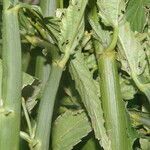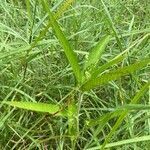Herb, usually annual, taprooted and also often rooting at the lower nodes; stems erect, subterete, striate, sometimes fistulose, usually not with prominent aerenchyma at base, ca 3-10 dm high, hirsute with gland-tipped hairs intermixed with appressed, relatively inconspicuous, sharp-pointed hairs. Leaves membranous; petioles 1.5-2.5 mm long, usually hispidulous and prominently pubescent with glandular hairs; stipules lanceolate, 2-4.5 mm long, 0.5-1.1 mm broad, often mar-ginally ciliate with glandular and/or non-glandular hairs; blades variable in shape (ovate or elliptic to lanceolate or even linear lanceolate), mostly 4-10(-12) cm long, 0.5-5 cm broad, sparsely pubescent (with both glandular and non-glandular hairs) to glabrate on both sides, the midrib and veins (ca 6-15 on a side) prominent, the primary veins straight, the secondaries tenuous, perpendicular to primaries (venation thus ? scalariform), the base obtuse or rounded to sub-cordate, the margins rather sharply serrate and minutely scabrous, with ca (10-) 15-35 teeth on a side, the apex broadly rounded to more often distinctly narrowed or pointed. Racemes spiciform, mostly 4-7 cm long, with (1-)2 or 3(-5) basal 9 and several distal c flowers; rachis hispidulous throughout, usually with glandular setae at least on the peduncle; bracts acute, persistent, glabrous. Sta-minate flowers with short glabrous pedicels; calyx glabrous, acutely lobed; petals 5, subequal, obovate, ca 1.5 mm long; stamens 10, the upper filaments as long as or longer than anthers, the lower filaments nearly contiguous to upper ones, shorter than the anthers, the anthers ca 0.5 mm long; pistillode apically 2-4-lobed, 0.6-0.8 mm high. Pistillate flowers subsessile, the very short glabrous pedicels less than 1 mm long even in fruit; calyx-lobes 5-9, usually unequal (with 4-6 larger inner lobes and 1-4 smaller outer ones), flattish, thin, not ribbed, acute, ordinarily copiously glandular-hirsute on margins and back, the longer ones ca 3.5-5 mm long in fruit; petals subequal, narrowly elliptic, pointed, (0.8-)1.3-1.9 mm long, 0.3-0.7 mm broad, not exserted beyond the calyx-lobes, + deciduous; ovary glabrous proximally, densely glandular-muricate distally, the styles 1.1-1.7 mm long, usually deeply 5-7-lobed, the lobes slender. Capsules 5.1-5.7 mm in diam, stramineous-green with dark green verrucae; seeds spheroidal, fuscous, 2.4-2.7 mm in diam.
More
Herbs, 25–100 cm; indumentum of glandular and nonglandular hairs, glandular hairs coarse, erect, thick-based, and gland-tipped (especially abundant on stems and petioles). Stems erect, moderately to densely hairy, with gland-tipped hairs and finer, usually appressed, nonglandular hairs; older stems 4–7 mm diam. Leaves: petiole 0.3–2.5(–3.5) cm; blade narrowly ovate, lanceolate, or linear-lanceolate, 6–15 × (0.6–)1–6 cm (L/W = 2–7(–11)), base usually rounded or obtuse, rarely acute, apex acute or narrowly acute, surfaces glabrescent or sparsely, mostly appressed-hairy. Inflorescences 2–14 cm, peduncle 1–7 cm, fertile portion 1–9 cm, with (1–)2–4 pistillate flowers. Staminate flowers: petals narrowly obovate, 1.4 mm, ± equal, not or somewhat exerted beyond calyx. Pistillate flowers: sepals ovate or elliptic, longest 2–3.2 mm, becoming 3.5–5.5 mm in fruit; petals 1–2(–2.4) mm; ovary densely covered in bulbous-based, gland-tipped trichomes. Capsules 5–7 mm wide, trichomes conic proximally, hairlike distally, gland-tipped. Seeds brown, 2.5–3 mm diam. 2n = 22.
An annual herb. The leaves are long and narrow and have teeth along the edge. It grows in water. The flowers are white.


